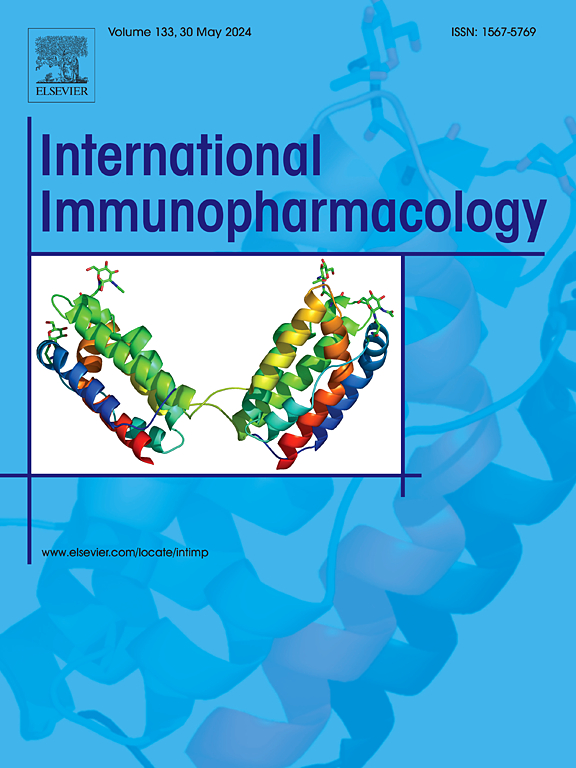补体C1S是一种潜在的预后生物标志物,与胶质瘤中M2巨噬细胞的浸润有关:从生物信息学到综合实验验证。
IF 4.8
2区 医学
Q2 IMMUNOLOGY
引用次数: 0
摘要
胶质瘤是中枢神经系统最常见的恶性肿瘤,传统临床治疗延长胶质瘤患者生存期的能力有限。大量证据表明,免疫系统在消灭恶性细胞和阻止肿瘤转移方面发挥着关键作用。因此,肿瘤免疫疗法已成为解决胶质瘤患者临床难题的一个前景广阔的途径。补体系统是一种天然免疫系统,是免疫反应中的一道重要防线。C1S 在激活经典补体系统中起着关键作用。然而,很少有研究关注 C1S 在胶质瘤肿瘤发生和发展中的作用。在这项研究中,我们通过将多个公共数据库中的胶质瘤队列与我们内部的独立队列相结合,证实了 C1S 在 GBM(IV 级)和低级别胶质瘤(LGG,II-III 级)中的上调,而且 C1S 表达水平的升高预示着胶质瘤的不良预后。Cox回归分析发现,C1S是胶质瘤患者的一个重要预后指标。此外,基因功能富集分析表明,C1S 参与细胞免疫、T 细胞活化、巨噬细胞分化和细胞增殖。进一步的实验证明,C1S 能促进肿瘤细胞增殖、细胞迁移和裸鼠颅内肿瘤生长。更重要的是,我们评估了 C1S 在免疫浸润中的作用。这些结果表明,C1S 与胶质瘤中的多种免疫细胞类型密切相关,尤其是 M2 巨噬细胞。胶质瘤组织芯片免疫组化分析和 M2 巨噬细胞浸润试验进一步验证了我们的发现。这些发现共同揭示了 C1S 在胶质瘤肿瘤发生、发展和肿瘤免疫微环境中的潜在关键作用,有助于进一步了解胶质瘤的发病机制并指导免疫疗法。本文章由计算机程序翻译,如有差异,请以英文原文为准。
Complement C1S is a potential prognostic biomarker and associated with M2 macrophage infiltration in gliomas: From bioinformatics to comprehensive experimental validation
Glioma is the most common malignant tumor of the central nervous system, and the ability of traditional clinical treatment to prolong the survival of glioma patients is limited. A substantial body of evidence underscores the pivotal role of the immune system in eradicating malignant cells and impeding tumor metastasis. Consequently, tumor immunotherapy has become a promising avenue to address the clinical conundrum faced by glioma patients. The complement system is a natural immune system that is an important line of defense in the immune response. C1S plays a key role in activating the classical complement system. Nevertheless, few studies have focused on the role of C1S in glioma tumorigenesis and progression. In this study, we demonstrated that C1S was upregulated in GBM (Grade IV) and low-grade gliomas (LGG, Grade II-III) by combining glioma cohorts from multiple public databases with our internal independent cohorts and that increased C1S expression levels predict a poor prognosis for gliomas. Cox regression analysis identified C1S as an important prognostic indicator for glioma patients. In addition, gene functional enrichment analysis demonstrated that C1S was involved in cellular immunity, T-cell activation, macrophage differentiation, and cell proliferation. Further experiments demonstrated that C1S facilitates tumor cell proliferation, cell migration and intracranial tumor growth in nude mice. More importantly, we evaluated the role of C1S in immune infiltration. These results suggested that C1S was closely related to a variety of immune cell types in glioma, especially M2 macrophages. Our findings were further validated via glioma tissue microarray immunohistochemical analysis and an M2 macrophage infiltration assay. Together, these findings revealed the underlying critical role of C1S in glioma tumorigenesis, progression, and the tumor immune microenvironment, contributing to further understanding of glioma pathogenesis and guiding immunotherapy.
求助全文
通过发布文献求助,成功后即可免费获取论文全文。
去求助
来源期刊
CiteScore
8.40
自引率
3.60%
发文量
935
审稿时长
53 days
期刊介绍:
International Immunopharmacology is the primary vehicle for the publication of original research papers pertinent to the overlapping areas of immunology, pharmacology, cytokine biology, immunotherapy, immunopathology and immunotoxicology. Review articles that encompass these subjects are also welcome.
The subject material appropriate for submission includes:
• Clinical studies employing immunotherapy of any type including the use of: bacterial and chemical agents; thymic hormones, interferon, lymphokines, etc., in transplantation and diseases such as cancer, immunodeficiency, chronic infection and allergic, inflammatory or autoimmune disorders.
• Studies on the mechanisms of action of these agents for specific parameters of immune competence as well as the overall clinical state.
• Pre-clinical animal studies and in vitro studies on mechanisms of action with immunopotentiators, immunomodulators, immunoadjuvants and other pharmacological agents active on cells participating in immune or allergic responses.
• Pharmacological compounds, microbial products and toxicological agents that affect the lymphoid system, and their mechanisms of action.
• Agents that activate genes or modify transcription and translation within the immune response.
• Substances activated, generated, or released through immunologic or related pathways that are pharmacologically active.
• Production, function and regulation of cytokines and their receptors.
• Classical pharmacological studies on the effects of chemokines and bioactive factors released during immunological reactions.

 求助内容:
求助内容: 应助结果提醒方式:
应助结果提醒方式:


